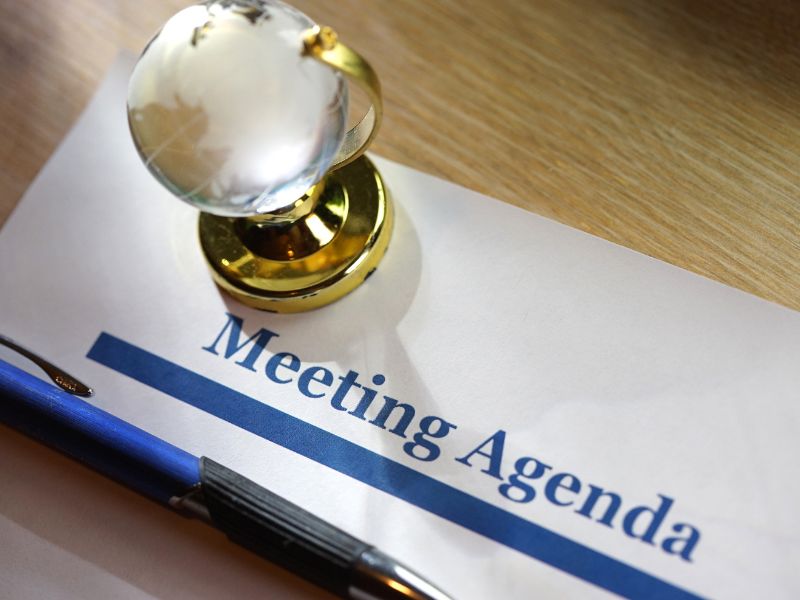When running a business meeting, you typically manage and keep track of many people and activities. To make this process more efficient, most meeting leaders like to use an agenda template. This will ensure you get through all the relevant topics quickly, the meeting stays on track, and everyone makes good use of their time together.
Creating a meeting agenda involves several essential steps to ensure it is a success. These steps include identifying the objective, creating a list of topics, ensuring everyone understands the purpose of your meeting, setting a timeline, preparing materials, and assigning tasks.
In this article, we’ll outline the six crucial steps you should consider when creating an effective meeting agenda. We’ll also take a peek at some useful meeting agenda template choices.
Identify the purpose of the meeting
For your own preparation and the sake of getting everyone on the same page, determining the purpose of the meeting is the most crucial aspect of the agenda. There are four essential questions to think about before planning any meeting:
- What are your key reasons for gathering your team for a meeting?
- Do you seek their input on a matter?
- Is there a project you’d like to keep them updated on?
- Is there a decision you’d like to make as a group?
Starting with the final goal in mind ensures that the meeting’s aim is crystal clear and that the topics on the agenda are all relevant to reaching that goal. Establishing a reasonable objective will help your meeting stay on track.
Create a list of meeting topics
Create a list of the meeting topics you must address to reach your goals. Plan out the steps you should take, and think about the order of importance for the topics and the decisions you need to make. Consider what knowledge the team needs to understand the topic and make decisions.
Set a time line for each agenda item
Next, estimate how long it will take you to finish each discussion. Meeting this time line ensures you have adequate time to discuss everything on the agenda. It also encourages people to tailor their queries and comments to the allotted time.
You may save even more time in meetings by using a consent agenda. Consent agendas combine often-raised issues into a single line item you can easily check off.
Assign tasks to each participant

Source: Freepik
There will inevitably be people on your team who know more about certain subjects than you. If another member of your team is going to lead a discussion, however, make sure they understand what you expect from them. You can label these members under their assigned topics. This not only allows people time to prepare for the meeting but also helps others know where to direct their questions and concerns in advance.
Prep everyone before the meeting
Is there anything special you’d like people to prepare for the meeting? Who is in charge of the different topics? Don’t put someone on the spot in a meeting to provide insight about a topic or data. Let them know ahead of time and give them time to prepare.
Prepare materials for the meeting

Source: Freepik
Distributing all necessary project files and materials in advance through team meeting agendas might help the meeting achieve its goals. This procedure sets the stage for everyone in the meeting and gives them a voice in the discussion.
Meeting agenda templates
There are several helpful samples of meeting agendas to use as guides for planning your own agenda template for meetings. Below is an example of a weekly team meeting agenda you can use for your own meetings. Use this as your starting point for brainstorming how to best utilize your team’s talents and time.
Weekly team meeting
Date:
Time:
Location:
Agenda details
Goals:
Topic 1: Quick check-in
Time:
Purpose:
Leader:
Topic 2: News and updates
Time:
Purpose:
Leader:
Topic 3: The past week’s learnings, successes, and failures
Time:
Purpose:
Leader:
Topic 4: Top priorities for the week
Time:
Purpose:
Leader:
Topic 5: Potential challenges
Time:
Purpose:
Leader:
Topic 6: Next steps and actions to take
Time:
Purpose:
Leader:
Topic 7: Meeting summaries
Time:
Purpose:
Leader:
a. What went smoothly during this meeting?
b. How can we improve for the next meeting?
Additionally, several websites offer meeting agenda templates for companies to use. An example is ClickUp, which provides a variety of templates, including one-on-one meeting agendas, scrum meeting agendas, all-hands team meeting agendas, and project postmortem templates. MeetingBooster also provides team meeting agenda templates, while Docket offers project kickoff meeting agenda templates.
Conclusion
We hope that this overview of agendas has helped you better understand how to prepare effective meetings and why it is crucial to have a well-defined and purposeful agenda. It’s essential to take the time to get everyone on the same page and to clearly communicate your expectations for the meeting and the outcome you’re aiming to achieve.

